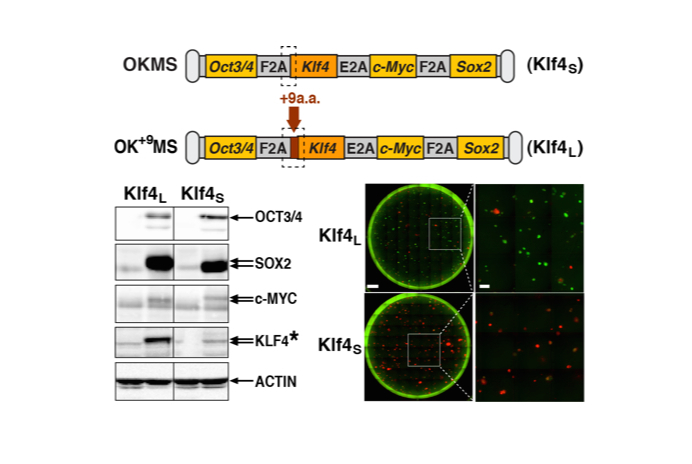
Research Activities
Research Activities
Publications
March 13, 2015
OSKM stoichiometry determines iPS cell reprogramming
Anyone in the field of cell reprogramming recognizes Oct3/4, Sox2, Klf4, and c-Myc, or "OSKM", as the Yamanaka factors that led to the first iPS cells. Originally, these four genes were delivered as individual (monocistronic) viral vectors. In order to simplify protocols, researchers began to deliver them using single polycistronic vectors, where the OSKM genes are linked as mRNA but still produce four separate proteins to induce reprogramming. However, not all vectors are built the same, and it turns out their subtle variations may influence both reprogramming efficiencies and outcomes. Specifically, the length of Klf4 appears to be a significant factor in determining whether a somatic cell is reprogrammed to the pluripotent state. Klf4 was first reported in 1996 by two independent studies. However, despite investigating the same gene, those two reports predicted different locations of the start codon in the mRNA sequences, which when translated result in proteins that differ by nine amino acids in length. Which isoform is used for reprogramming depends on the lab. "Some labs use short Klf4, some labs use long. Some labs have even switched between the two lengths," says Knut Woltjen, Ph.D., Associate Professor of the Dept. of Reprogramming Science.
Curious if these amino acids could explain the diverse reprogramming efficiencies that have been reported by different labs, Woltjen and his team employed piggyBac transposons to deliver various polycistronic reprogramming factors, controlling for the Klf4 length. They found that transfection with polycistronic vectors carrying the shorter Klf4 (Klf4S) resulted in more cells that initiated reprogramming, but failed to complete it, leaving them as partially reprogrammed. In contrast, the majority of cells transfected with vectors carrying the longer Klf4 (Klf4L) became true iPS cells. Deeper investigation found that polycistronic vectors with the Klf4L isoform showed much higher Klf4 protein expression, suggesting that the stoichiometry of the reprogramming factors could be the critical factor underlying reprogramming efficiency. According to Woltjen, "The stoichiometry is so important. No matter what system you use to establish it, the stoichiometry has a major impact on the quality of iPS cells." Other studies have noted stoichiometry effects, but Woltjen's team is the first to propose variation in a single factor's mRNA sequence as a determining factor in establishing stoichiometry. Supporting their hypothesis, appending Klf4S with the missing nine amino acids switched the Klf4 expression and reprogramming dynamics to mirror those seen with Klf4L.
Moreover, these differences in stoichiometry were reflected in gene expression patterns observed during the reprogramming process. Although reprogramming with either Klf4S or Klf4L led to the activation of many hallmark reprogramming genes, the majority of gene regulation was clearly dissimilar. Studying the reprogramming process induced by eight different polycistronic vectors, the team observed that both reprogramming performance and gene expression bifurcated with the Klf4 isoform. This finding may suggest that for popular vectors containing Klf4S, a simple modification of the Klf4 length could augment the number of properly reprogrammed cells. For researchers studying the reprogramming process itself, such vector differences raise caution when directly comparing reprogramming data between labs.
Interestingly, the differences associated with Klf4 length appeared mainly when reprogramming with polycistronic vectors. If instead either Klf4S or Klf4L was induced using a monocistronic vector in combination with an OSM polycistronic vector, the isoform dependency of reprogramming disappeared. These results suggest that the polycistronic design of the vector has some innate effect on the expression level of Klf4, while the protein function itself may not be affected. Nevertheless, inappropriate ratios of monocistronic vectors could also lead to a similar stoichiometry effect. Shin-Il Kim, Ph.D., first author of the study, stresses that just recognizing OSKM is not enough when reprogramming and that one must also be aware of the relative expression of the four genes. "Initially, we had no idea how much of a difference it [the 9 amino acids] would make. It goes to show how important it is to really know the materials you are working with."

(top) Adding 9 amino acids before Klf4 to switch the isoform from Klf4S to Klf4L subtly lengthens the transgene. (bottom left) This lengthening causes a significant increase in the Klf4 protein expression. (bottom right) It also increases the proportion of reprogrammed cells (green) to partially reprogrammed cells (red).
Paper Details
- Journal: Stem Cell Reports
- Title: KLF4 N-terminal variance modulates induced reprogramming to pluripotency
- Authors:
Shin-Il Kim, Fabian Oceguera-Yanez, Ryoko Hirohata, Sara Linker, Keisuke Okita,
Yasuhiro Yamada, Takuya Yamamoto, Shinya Yamanaka, Knut Woltjen






















